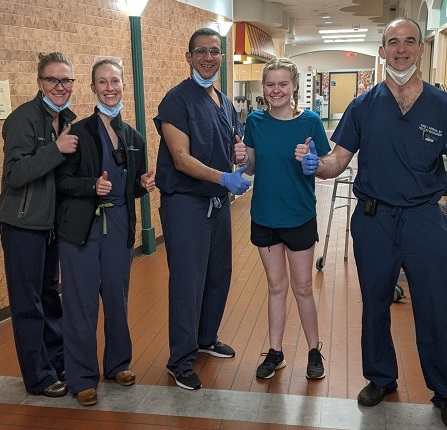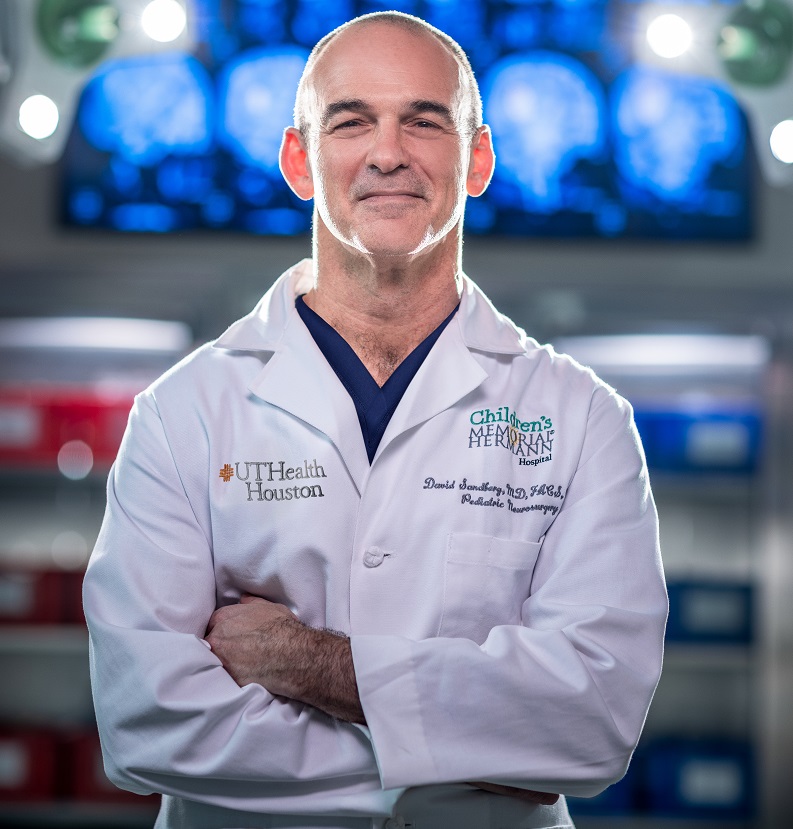
Marching on with hope
Reimagining care of pediatric brain tumors
Abbi Evans and her family mark a routine eye exam in December 2020 as the beginning of a journey that forever changed their lives. When the optometrist noted something odd about Abbi’s optic nerve and referred her to a specialist, the Evans family felt something was wrong.
“You go to your eye exam expecting to leave with a prescription for glasses or contacts, but we left with a prescription for an MRI and a growing fear,” says Abbi’s mother, Christy. “Before long, we learned that our daughter had three brain tumors.”
A junior in high school in Corpus Christi, Texas, Abbi’s life was bustling: In addition to excelling in her classes and preparing for college entrance exams, she was a talented and passionate clarinetist in her school’s marching band. Aside from some unusual headaches, nothing suggested Abbi had anything as serious as a brain tumor, much less three of them.
Further testing revealed that Abbi’s tumors were benign and caused by neurofibromatosis type 2, a rare genetic disorder characterized by the continued growth of noncancerous tumors in the nervous system. With no cure, patients like Abbi require lifelong monitoring to keep the tumors in check.
Doctors promptly ordered additional MRIs to check the rest of Abbi’s nervous system and found another benign tumor, called an ependymoma, on her spinal cord. With the tumor encroaching on vital nerves in her spinal cord, the family contacted McGovern Medical School at UTHealth Houston and UTHealth Houston Neurosciences neurosurgeon David I. Sandberg, MD, Dr. Marnie Rose Professor in Pediatric Neurosurgery and Director of the Division of Pediatric Neurosurgery. He advised them to drive to Houston for emergency surgery to remove the tumor.
Although the trip between Corpus Christi and Houston is typically an uneventful 3.5-hour drive, a historic weather event was brewing. Sweeping from the northwest, Winter Storm Uri strengthened into a life-threatening natural disaster and took aim at Houston.
“Dr. Sandberg had no choice but to immediately schedule Abbi for surgery the day after we arrived, which was when the storm was predicted to hit,” says Christy. “He told us he would walk to the hospital for Abbi if he had to, and when the storm shut down the city the next day, he kept his word.”
Sandberg trudged through more than a mile of sleet, snow, and ice to reach Children’s Memorial Hermann Hospital. Despite an unpredictable commute, Abbi’s surgery went as planned, and Sandberg successfully removed the tumor while preserving her spinal cord.
Following surgery, Abbi spent five weeks in physical rehabilitation at TIRR Memorial Hermann to regain her mobility and coordination. Her therapy team was led by Stacey L. Hall, DO, Director of Pediatric Rehabilitation Medicine at TIRR Memorial Hermann.

“One of my main goals following surgery was to rejoin the marching band,” Abbi recalls. “My therapists incorporated my clarinet into our sessions by having me clean it, put it together, and practice breathing exercises.”
Abbi completed her rehabilitation just in time to take the field again with her marching band. Building off that momentum, she graduated eighth in her class, and in fall 2022, she will begin her college education with the hope to one day work in the health care field.
“I may face more challenges and surgeries, but I know I’m in the best hands with Dr. Sandberg,” says Abbi. “I want to take these experiences and the example Dr. Sandberg provided to care for my own patients in the future.”
Banding together for better outcomes
Central nervous system tumors strike more than 4,000 children each year, and they hold the terrible distinction of being the deadliest type of childhood cancer. While benign tumors like Abbi’s can be extremely dangerous, cancerous tumors present additional challenges of growing rapidly, spreading throughout the body, and destroying nearby tissues.
“The brain has an incredible defense system called the blood-brain barrier, which protects it against toxins and infections, including traditional chemotherapy and other cancer medications,” says Sandberg, who conducts groundbreaking research to provide more effective treatment options for children with brain tumors. “To bypass this defense system, physicians usually have to administer these therapies at large doses, which can make children severely ill. We are researching how to sidestep those issues by delivering medications directly into the brain to target tumors.”
In one clinical trial, Sandberg’s team is studying whether a combination of two medications—a traditional chemotherapy and an antibody-based drug that activates the immune system to destroy cancer cells—infused into the brain can treat children with recurrent malignant brain tumors.
“By combining these medications and infusing them into the brain, we hope to eliminate the tumor cells without causing toxic levels of the medications in the bloodstream,” says Sandberg. “This type of treatment could allow us to avoid the devastating side effects of traditional chemotherapies, which include a weakened immune system, extreme fatigue, and hair loss. We want to give growing children the best chance for a healthy childhood and a full, happy life.”

Throughout the Many Faces. One Mission. campaign, philanthropy has empowered Sandberg and his team to pursue breakthroughs in the way we treat central nervous system tumors in children. The Dr. Marnie Rose Foundation established the Dr. Marnie Rose Professorship in Pediatric Neurosurgery in memory of Marnie Rose, MD, a graduate of McGovern Medical School who passed away at the age of 28 from a rare form of brain cancer. Additionally, Shaun Varghese, MD, and his wife, Cristina Marchesano, MD—both graduates of McGovern Medical School—established the THINK Neurology Chair in Pediatric Tumor Research.
“The power of these endowments is that they will continue to provide resources in perpetuity to advance our work,” says Sandberg. “They stand as testaments to the enduring impacts made by Drs. Rose, Varghese, and Marchesano on our communities.”
Federal funding for innovative research like Sandberg’s is extremely limited and competitive, making donor support vital for continued advances.
“We do everything with the mission to bring hope to children with central nervous system tumors,” says Sandberg. “Philanthropy enables us to harness the ingenuity and expertise at UTHealth Houston to nurture one-of-a-kind ideas and grow them into initiatives that make a difference for families here and around the world.”
Cancer can bring life to a standstill, but the ingenuity of UTHealth Houston experts like Sandberg—bolstered by the generosity of donors—continues to help families such as Abbi’s find hope and march on.

